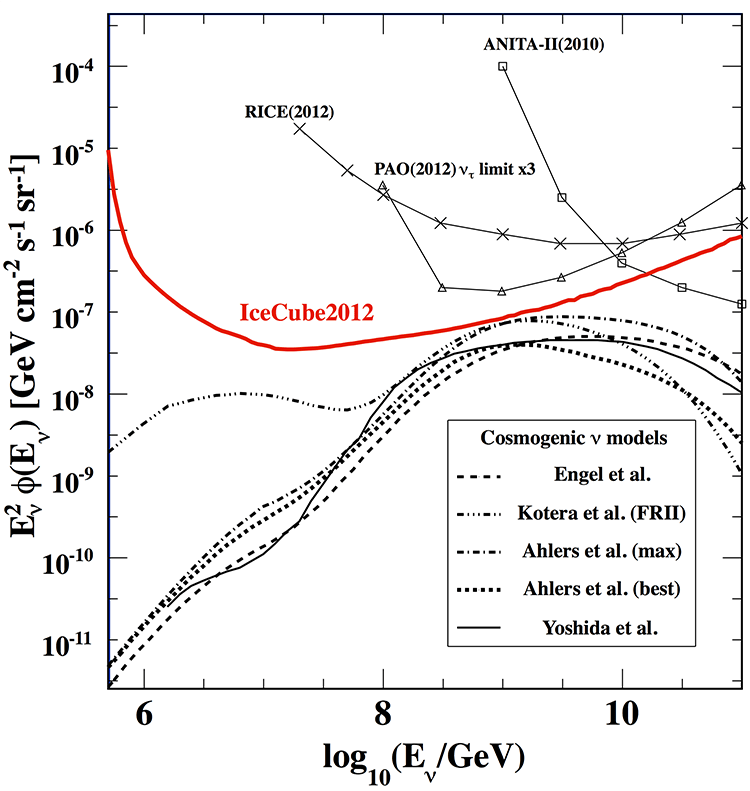The search for cosmogenic neutrinos, those produced through the interactions of ultra-high-energy cosmic rays (UHECRs) with photons from the cosmic microwave background radiation (CMB) that fills our Universe, requires huge detectors. This we know, but exactly how big the detector needs to be is still unknown.
IceCube, the first cubic-kilometer neutrino detector ever built, might be the first telescope to observe a flux of cosmogenic neutrinos. However, the flux might be so low as to be out of reach even for IceCube. Bigger detectors have been proposed, like the Askaryan Radio Array and ARIANNA, but they are either under construction or still in design.
In July 2012, the IceCube Collaboration announced the observation of the two highest-energy neutrinos ever observed, with energies around 1 PeV. Today, the collaboration presents new results that rule out the possibility—at a confidence level greater than 90%—that these are cosmogenic neutrinos. However, the long exposure of the analyzed data, from May 2010 to May 2012, and the lack of detected events with higher energies, have allowed a new probe into the cosmogenic neutrino flux,
$$ \small E^{2} \; \phi {\nu{e} + \nu_{\mu} + \nu_{\tau}} \; < \; 1.2 \times 10^{-7} \; GeV cm^{-2}sec^{-1} $$
at 1 EeV, which has been used to set the most stringent limit for the energy range from 1 PeV to 10 EeV. This analysis has just been submitted to the journal Physical Review D.

Cosmogenic production is considered to be the main source of neutrinos at energies from 100 PeV to 10 EeV. However, their flux is expected to be so low that a very large exposure is required, such as that from a cubic-kilometer-volume neutrino detector.
IceCube, the first detector of this size, is also an omnidirectional neutrino telescope with very high uptime, which extends its sensitivity for cosmogenic neutrino searches. Still, only on the order of one event per year is expected for extremely high-energy neutrinos, assuming a proton composition for UHECRs. A heavier composition of UHECRs would lead to a decrease of the neutrino flux, which varies widely for each model and would be at least 2 to 3 times lower if the iron composition model is assumed.
The IceCube researchers performed two different tests on several cosmogenic neutrino models.
First, they investigated whether any of the existing models can account for the detection of the two PeV events, now known as Bert and Ernie, and the simultaneous nondetection of higher-energy neutrinos. They found that the IceCube observation is inconsistent with all cosmogenic models at a confidence level greater than 90%, thus rejecting that the two PeV neutrinos in IceCube are cosmogenic particles.
Second, they set more stringent constraints on these cosmogenic neutrino models. To do that, they calculated the event rates for neutrinos above 100 PeV, since most cosmogenic neutrinos are expected to have energies above this threshold, with the peak at about 1 EeV. The null observation of events above 100 PeV leads to new constraints for strong source-evolution models, such as some radio galaxy or some gamma-ray burst models. Those models predict high neutrino fluxes and, therefore, cannot be responsible for the bulk of UHECRs.
“Among the source models that have been constrained, I would highlight the Fanaroff-Riley type II (FR-II) radio galaxy model, the long-standing favorite candidate for the UHECRs origin. For a proton composition of cosmic rays, the model expects 2.9 events in IceCube, and we have observed none. We have ruled out this model at a confidence level greater than 90%,” explains Keiichi Mase, an IceCube researcher at Chiba University in Japan.
Finally, a model-independent upper limit to the cosmogenic neutrino flux was calculated, resulting in the most stringent limit for the energy range from 1 PeV to 10 EeV.
Info “Probing the origin of cosmic-rays with extremely high energy neutrinos using the IceCube Observatory,” IceCube Collaboration: M.G. Aartsen et al. Physical Review D88 (2013) 112008, arXiv.org:1310.5477 prd.aps.org